Barkers National Park, Grand Cayman
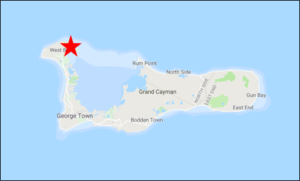
For visitors whose interest in the Caymanian avifauna extends beyond the endemics and other specialties of the islands, Barkers National Park provides access to diverse habitats in a compact area. As most of the protected area is either mangrove swamp or lagoon, the park is mainly a haven for waterbirds, most of which are migratory. Various species of resident and migrant landbirds can be found in the mangroves and adjacent dry forest.
Orientation
Directions
Barkers National Park is at the farthest point in West Bay, about 30 minutes’ drive (15 km) north of the George Town pier, via the Esterly Tibbets Highway.
At the end of the Highway, turn left on Batabano, then right on Mount Pleasant, then right on Conch Point Road, which terminates in the park.
(Some wayfinding apps may direct you to turn right on Batabano, which is the shortest route to a park boundary, but does not lead into the park’s road and trail system.)
Attractions
Within two miles of Barkers, the district of West Bay has three noted tourist attractions: the Cayman Turtle Centre, Hell, and Seven Mile Beach.
Cayman Turtle Centre. If you’ve ever wanted to handle a young sea turtle or see several hundred sea turtles in one place, this is the place for you. The Turtle Centre serves several related purposes—aquarium, marine theme park, conservation nursery, and meat ranch—and is the most visited tourist attraction in the Cayman Islands.

Juvenile Green Turtle at the Cayman Turtle Center. © Jack Kennard
Originally established to supply the turtle meat market and avert the collapse of wild sea turtle populations, its mission and conditions of captivity have made it a target for animal rights activists. It can also be seen as a practical conservation organization that actively restores wild populations and reaches a wide public audience with an educational message.
Visitors have two options: a basic admission fee ($18) to see the turtle ponds, and a higher fee ($45) for access to the whole facility, including a large aviary, shark exhibit, and a coral reef lagoon for snorkeling.
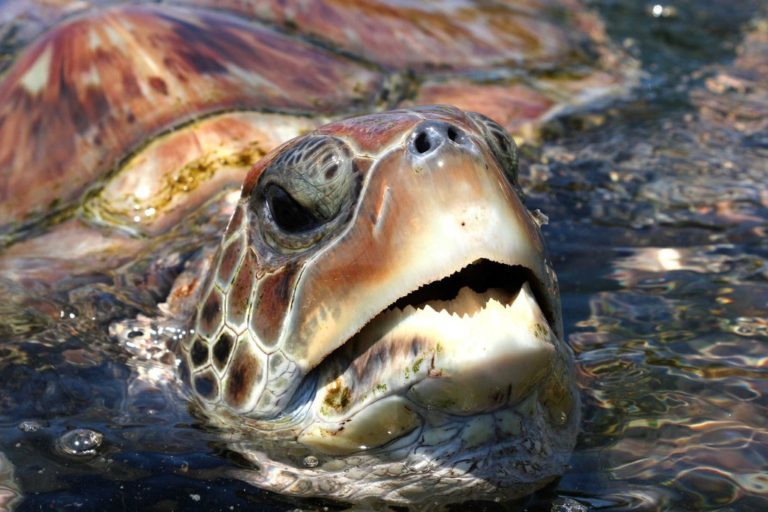
Adult Green Turtle at the Cayman Turtle Center. © Cayman Simon
Hell. If tropical paradise bores you, try a slice of tropical hell. This is, of course, a geological reference. The underlying substrate of Grand Cayman is largely composed of jagged rock formations, and a particularly nasty section of the indigenous hellscape has been preserved and placed on display. The post office will stamp your postcards accordingly.
For its own intrinsic qualities, Hell is probably not worth a special trip (except for those who are especially fond of its name), but it rounds out a visit to the Turtle Centre or Barkers.
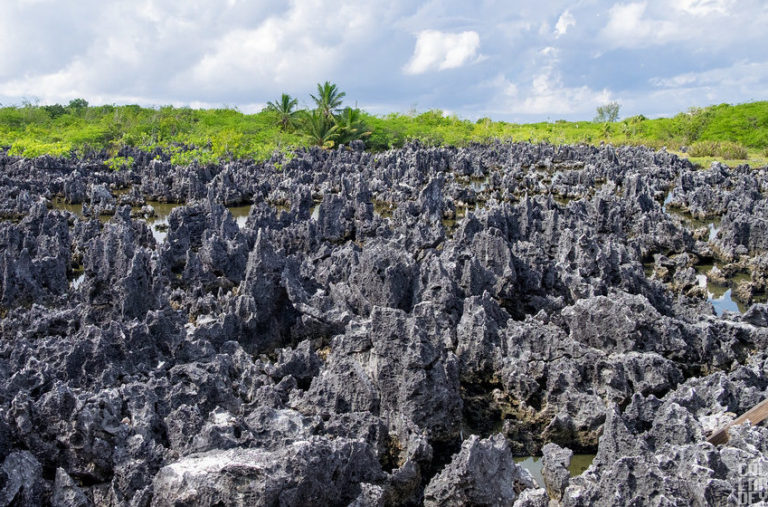
Hell.
Seven Mile Beach. Sticklers for accuracy may be disturbed to learn that it is actually closer to six miles long, but most beachgoers will be inclined to forgive the exaggeration. Seven Mile Beach has been voted the best (or “most perfect”) beach in the Caribbean in polls of cruise ship travelers.
The beach is, in effect, the front yard of Grand Cayman. Most of the major hotels, restaurants, and banks are located along the boulevard that parallels it.
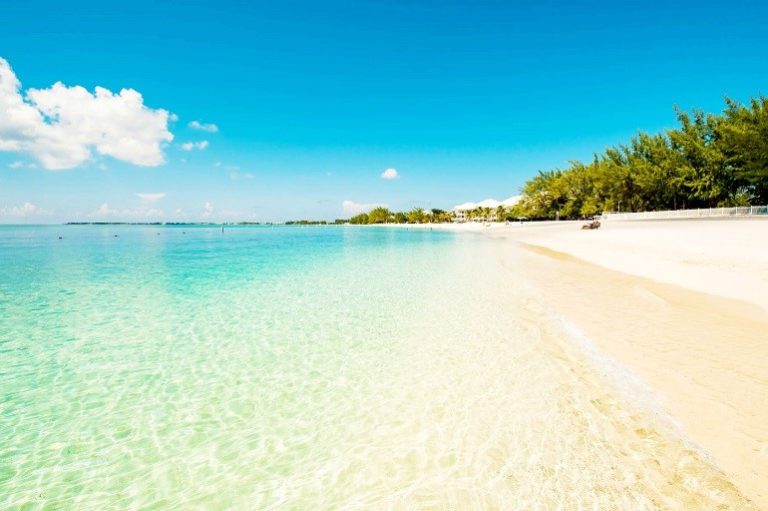
Seven Mile Beach.
Birdfinding
Barkers National Park is conveniently laid-out for birdwatching: a habitat mosaic of woodland, scrub, mangrove, pond, and seashore criss-crossed by a network of dyke roads.
Exploring all the major habitat types, it is possible to find several species of waterfowl, herons, shorebirds, and terns, along with mangrove specialists such as White-crowned Pigeon, “Golden Warbler”, Northern Waterthrush, and other wintering warblers (predominantly Palm).
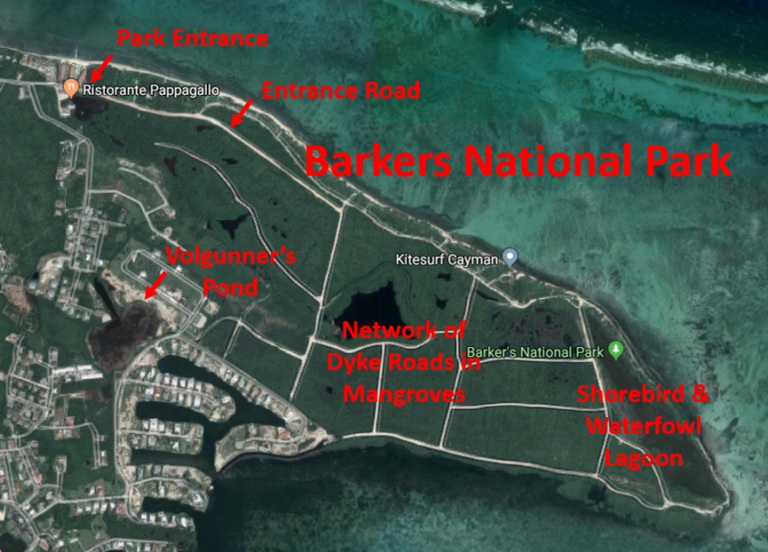
The entrance road initially passes through dense brush where some Cayman endemics and other local specialties can sometimes be found, including: “Grand Cayman Woodpecker”, Caribbean Elaenia, La Sagra’s Flycatcher, Loggerhead Kingbird, and “Cayman Bananaquit.”
Volgunner’s Pond. Immediately before the entrance to the park, Powery Road takes off to the right (south). This road leads to Volgunner’s Pond, which has nesting Antillean Nighthawks on its margins and is generally good for migrant shorebirds. The pond can also be reached more circuitously from the south side, either via Shorewinds Trail (a road), or on foot from the park’s trail system.
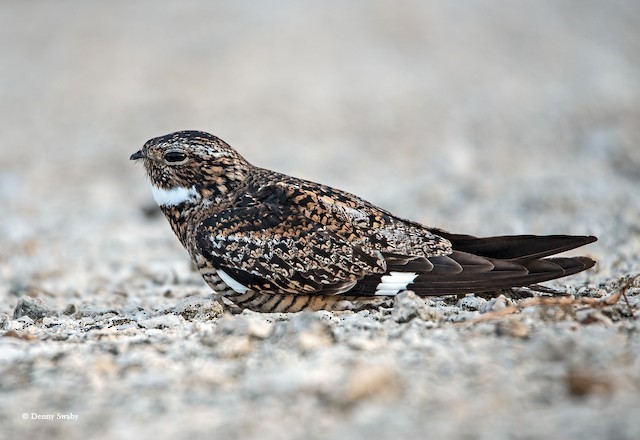
Antillean Nighthawk at Volgunner’s Pond. © Denny Swaby
Services
Accommodations
There are any number of expensive hotels along Seven Mile Beach, with the Ritz-Carlton being the largest and most conspicuous. Budget options are scarce.
Mid-Range. One of the best values along Seven Mile Beach is the Sunshine Suites Resort, which has fairly low rates and basic kitchens to help keep expenses down. The beach is three blocks away. As a bonus, however, Sunshine Suites is situated beside fields that are known hunting grounds for “White-winged Barn Owl”.
On the opposite side of the peninsula but still nearby, along North Sound, the Holiday Inn Resort offers probably the best value among Grand Cayman’s large, name-brand hotels. The Holiday Inn is family-oriented, with economical suites and recreational options that include excursions to Stingray City and the bioluminescent lagoon at Rum Point departing from its dock. Its rates are somewhat less competitive during school vacation periods.
Similarly priced, at the farthest tip of the peninsula in West Bay, near Barkers National Park and the Cayman Turtle Center, is the Cobalt Coast Resort, which caters especially to divers. It is on the waterfront and has a small sandy beach, but a jagged, dry reef separates the sand from the ocean. There is, however, a boardwalk and dock that give divers direct access to the ocean without having to leave the property.
Budget. In George Town proper, south of Seven Mile Beach, is the renowned budget hotel Eldemire’s Tropical Island Inn (a.k.a. Eldemire’s Guest House). It is a ten-minute drive from the airport and a five-minute walk from Smith Cove Beach.
There are a handful of bed-&-breakfasts that can be identified and arranged through AirBnB and other online booking services. One such option in West Bay, near Barkers and the Turtle Centre, that can be arranged directly with the owners, is Cayman Pace (+1-345-325-6540).
Food
Fine Dining. Ristorante Pappagallo, a local landmark restaurant of high quality, sophistication, and aesthetic distinction, is located at the entrance to Barkers National Park.
Another landmark restaurant in West Bay, a short walk from the Cayman Turtle Centre, is The Cracked Conch, which offers both waterfront dining and tableside diving—the restaurant’s patio has a stairwell into the ocean for snorkeling on an adjacent reef.
Mid-Range. For well prepared food in West Bay, and along Seven Mile Beach, at a much a lower price, try the Boggy Sand Caribbean Kitchen.
Budget. The best all-purpose grocery store in West Bay is Foster’s IGA, adjacent to Boggy Sand.
Notes
Barkers National Park is not as developed or regulated as its formal designation suggests. It is a public space, like a city park. There is no entrance gate and access is universal and multipurpose.